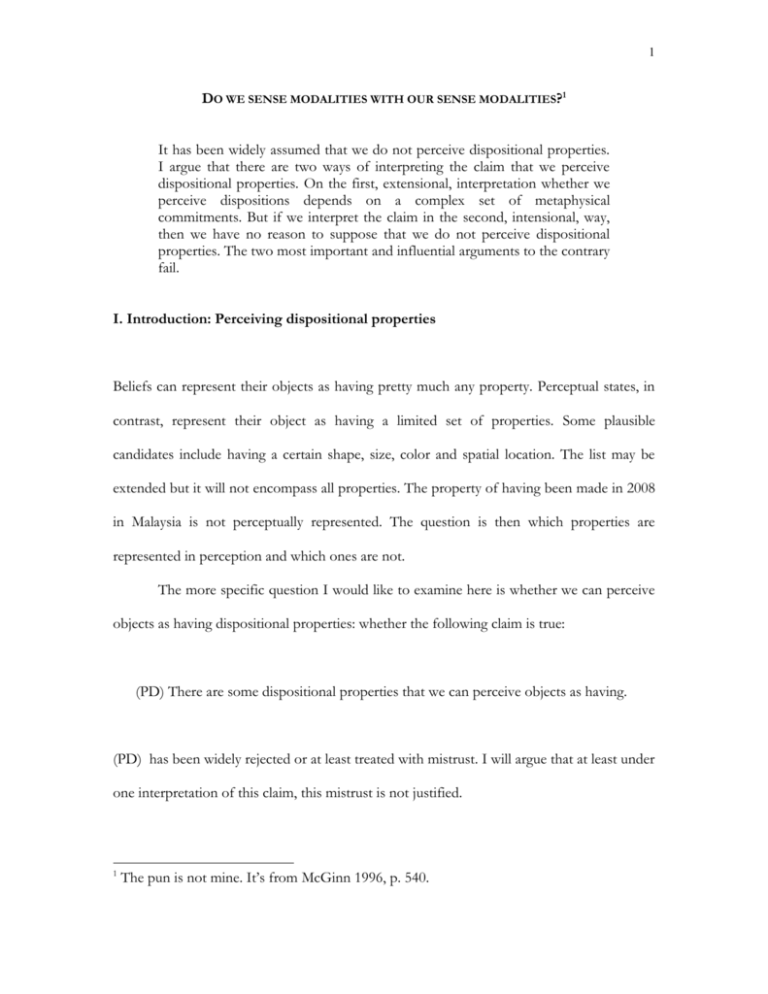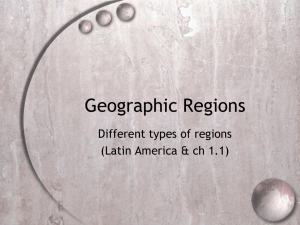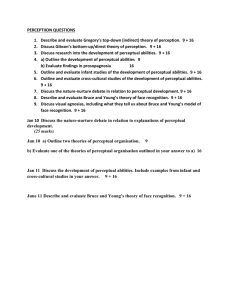Do we sense modalities with our sense modalities?
advertisement

1 DO WE SENSE MODALITIES WITH OUR SENSE MODALITIES?1 It has been widely assumed that we do not perceive dispositional properties. I argue that there are two ways of interpreting the claim that we perceive dispositional properties. On the first, extensional, interpretation whether we perceive dispositions depends on a complex set of metaphysical commitments. But if we interpret the claim in the second, intensional, way, then we have no reason to suppose that we do not perceive dispositional properties. The two most important and influential arguments to the contrary fail. I. Introduction: Perceiving dispositional properties Beliefs can represent their objects as having pretty much any property. Perceptual states, in contrast, represent their object as having a limited set of properties. Some plausible candidates include having a certain shape, size, color and spatial location. The list may be extended but it will not encompass all properties. The property of having been made in 2008 in Malaysia is not perceptually represented. The question is then which properties are represented in perception and which ones are not. The more specific question I would like to examine here is whether we can perceive objects as having dispositional properties: whether the following claim is true: (PD) There are some dispositional properties that we can perceive objects as having. (PD) has been widely rejected or at least treated with mistrust. I will argue that at least under one interpretation of this claim, this mistrust is not justified. 1 The pun is not mine. It’s from McGinn 1996, p. 540. 2 I make a distinction between two interpretations of the claim that we perceive dispositional properties and argue that if we interpret the claim in the first, extensional, way, then whether we perceive dispositions depends on a complex set of metaphysical commitments. But if we interpret the claim in the second, intensional, way, then we have no reason to suppose that we do not perceive dispositional properties. A brief note on the relevance of this issue. The question whether we perceive dispositional properties has mainly been discussed in connection with the dispositional theories of colour, as a potentially fatal argument against these theories: if we cannot perceive dispositional properties, then colour cannot be a dispositional property (Boghossian and Velleman 1989, McGinn 1996, but cf. Langsam 2000, Cohen 2009, 2010 and see Byrne 2001 for a summary). But this is not the only reason why we should be interested in the question about whether we perceive dispositional properties. A couple of quick examples: it has been argued that we perceive objects as being causally efficacious (Siegel 2005, 2009), as edible, climbable or Q-able in general (Nanay forthcoming), as agents (Scholl and Tremoullet 2000), as having some kind of normative character or value (Kelly 2010, Matthen 2010), as having moral value (Kriegel 2007) and as affording certain actions (for very different versions of this claim, see Gibson 1966, 1979, Bach 1978, esp. p. 368, Jeannerod 1988, Jeannerod 1994, esp. Section 5, Jeannerod 1997, Jacob-Jeannerod 2003, esp. pp. 202-204, Humphreys - Riddoch 2001, Riddoch et al. 1998, esp. p. 678). As these properties are dispositional properties, these claims seem to presuppose that we can perceive dispositional properties. And if it is true that we do not perceive dispositional properties, then these accounts are hopeless and should not be taken seriously. 3 In short, whether we perceive dispositions has serious implications for a number of important questions in philosophy of perception. There has been a lot of discussion about whether we perceive objects as having sortal properties: as tables, chairs, etc. If this is treated as an open question, it seems fair to reexamine the arguments that convinced the majority of the philosophical community that we do not perceive dispositional properties. II. Two interpretations of (PD) There are at least two different ways of understanding the question about whether we perceive dispositional properties, depending on whether we take perception to be an extensional or an intensional notion.2 Although these two questions are not always sufficiently distinguished in the literature on perceiving dispositions,3 they need to be kept apart. (It may be worth noting that there is a third question in the vicinity that I will not talk about: about whether it seems to us that we perceive dispositional properties (Langsam 2000). 2 Sellars 1978 makes a similar distinction in the context of discussing the representation of dispositional properties. 3 An important exception is Jonathan Cohen who is very explicit about focusing on the extentional interpretation only (Cohen 2009, p. 161, Cohen 2010, Section 2). Colin McGinn makes a similar, but importantly different, distinction between the highly intensional and not highly intensional contexts and argues that ‘looks’ is an operator that introduces the former (McGinn 1983, pp. 133-135 – note that he talks about ‘looks’ and not about ‘perceives’). In McGinn 1996, p. 538, he points out that he had been mistaken about the relevance of this distinction to the question about whether dispositions are perceived. 4 I agree with Byrne 2001’s doubts (esp. p. 244) about whether we can (and whether we should) resolve this third question.) II. a. First interpretation: perception as an extensional concept Perception can be taken to be extensional: in this case, the question is whether our perceptual system responds to, or tracks, dispositional properties. The perceptual system responds to some, but not all, properties. Take a random property of the perceived object and change it. If the perceptual system is influenced by this change, then this property is perceived in the extensional sense. And if the perceptual system is influenced by a change in a dispositional property of the perceived object, then at least some dispositional properties are perceived in the extensional sense. I call this interpretation extensional because if P and Q are coextensive properties, then if the perceptual system responds to property P, this implies that it also responds to property Q. The debated claim then is the following: (PDE) There are some dispositional properties that our perceptual states respond to. If we accept a version of the causal theory of perception (Grice 1961, Strawson 1974, Lewis 1980), then (PDE) amounts to a claim about (singular) causation. So answering the question about whether we perceive dispositional properties, in this extensional sense of the term, will involve taking sides in the grand debate about the properties of (singular) causation. In short, (PDE) seems to imply that dispositional properties are causally relevant in bringing about perceptual states. There are many ways of denying this. First, we can deny 5 that any properties are causally relevant, like Davidson once did (Davidson 1963, Davidson 1970, Davidson 1993). Second, even if we allow for the causal relevance of some properties, then whether dispositional properties can be among the causally relevant ones will depend on our stance on causal exclusion: if the categorical base of the disposition is causally efficacious and attributing causal efficacy to dispositional properties would amount to causal overdetermination (see Bennett 2003 and Mumford 1998 for a good summary). It has recently been argued that if we take the causally efficacious properties to be tropes, then dispositional properties and their categorical bases could both be causally efficacious (Ehring 1997, Ehring 1999, Robb 1997, Nanay 2009, but see Noordhof 2008’s worries). Whether or not this proposal works, it is easy to see that answering the question about whether dispositional properties are causally relevant in bringing about perceptual states requires taking a stance in some of the most important contemporary metaphysical debates (causal exclusion, tropes vs. universals, the causal efficacy of properties, etc). There is no easy way of arguing for, or against, (PDE) without taking sides in these grand debates. But note that the questions I started this paper with are not about (PDE). They are not about whether our perceptual states respond to dispositional properties, but rather about whether they attribute dispositional properties to the perceived scene. And this brings us to the second, intensional way of thinking about perception. II. b. Second interpretation: perception as an intensional concept But there is an intensional way of interpreting the question about whether we perceive dispositional properties. The question then is whether we perceive objects as having dispositional properties: whether we attribute dispositional properties to objects. 6 I assume that we perceive particulars out there in the world. Suppose I perceive an apple. This apple has a lot of properties. Some of them I represent it as having, but most of them I do not represent it as having. Of those properties that I represent it as having some, but not all, are perceptually represented. Hence, the claim that we perceive dispositional properties (in the intensional sense of the term) amounts to saying that some of those properties that we perceptually represent objects as having are dispositional. In other words, dispositional properties can show up in perceptual content (and not only in the content of our beliefs). Thus, on the intensional interpretation, the claim that we perceive dispositional properties amounts to the following: (PDI) There are some dispositional properties that are perceptually represented. I call this interpretation intensional because if P and Q are coextensive properties, then perceptually representing property P does not imply perceptually representing property Q. Note the difference between (PDE) and (PDI). (PDI) does not imply, and is not implied by, (PDE). A perceptual state can respond to, that is, it can be caused by, the instantiation of a property and yet fail to attribute this property. And conversely, a perceptual state can represent an object as having a property that this object fails to have. A couple of important clarifications are in order. First, in (PDI) and the preceding paragraph, I talked about perception in representational terms. I was assuming (like Peacocke 1992, Siegel 2010, Pautz forthcoming, Nanay 2010) that perceptual states are representations. But it is not the only way of thinking about perception. 7 It has been argued that perceptual states do not represent anything: they are not representations at all (Martin 2004, forthcoming, Campbell 2002, Travis 2004, Brewer 2006, forthcoming). They may be thought of as ‘presenting’ some properties, but they do not represent these properties. If we accept this framework, the question is what properties are presented or attributed in perceptual experiences. The important point is that regardless of whether we accept a ‘representational’ or a ‘relational’ view of perception (Campbell 2002), the question about which properties are perceived (interpreted in the intensionalist way) and which ones aren’t can (and should) be raised (see Siegel 2006). In what follows, I will use the ‘representational’ terminology and assume that perceptual states represent objects as having various properties, but the argument can be rephrased to fit the relationalist framework. Second, I am not assuming that perceptual representation needs to be conscious. Perception can be conscious or unconscious and some properties are represented perceptually and consciously, some others are represented perceptually and unconsciously. And a third set of properties are represented non-perceptually. (PDI) claims that at least some dispositional properties are perceptually represented (maybe consciously, maybe unconsciously). Third, the debates that make it important to clarify whether we can perceive dispositional properties are, with one important exception, all about (PDI) and not about (PDE). They are about whether we perceptually represent causal relation, edibility or the way objects are to be used and not about whether our perceptual system responds to these properties. The important exception is the debate about the ontology of color: here the question is about whether color properties themselves are dispositional properties, not about how we represent them. 8 I argue that we have no reason to reject (PDI). I will take the two most important arguments that are taken to be conclusive against (PDI) and point out that the first one is in fact an argument against (PDE) and the second one works only if we make some very dubious, and widely rejected, assumptions about the nature of perceptual content. III. The Modal Argument The received opinion is that (PDI) is false. As Colin McGinn says, “solubility is a property you infer rather than one that […] is directly revealed to you” (McGinn 1996, p. 540). McGinn’s reason for rejecting (PDI), which has become a standard reference is an argument I will label ‘the Modal Argument’. McGinn summarizes the Modal Argument in the following way: Dispositions are inherently modal notions – and you do not sense modalities with your sense modalities. You do not see what would obtain in certain counterfactual situation; you see only what actually obtains. […] Your eyes do not respond to woulds and might have beens. Dispositions depart too far from the actual world to be objects of simple sight (McGinn 1996, p. 540). Various versions of this argument have been so influential that even those who maintain that we perceive some dispositional properties accept the validity of this argument but point out that it fails to apply in the case of some special dispositional property. Michael Tye agrees with the deniers of (PD) that we do not perceive the textbook examples of dispositional properties, like being brittle or being elastic, but argues that we do perceive the hardness of a 9 lump of granite (which he takes to be a dispositional property, see Tye 2000, pp. 161-162). Jonathan Cohen explicitly accepts the Modal Argument for dispositional properties like being soluble or being fragile but argues that there are exceptions, and being red is one of them (Cohen 2009, pp. 160-163, Cohen 2010, Section 2). The Modal Argument is explicitly taken to apply against the intensional interpretation, that is, against (PDI). As McGinn says, “dispositions of whatever kind cannot themselves enter visual content” (McGinn 1996, p. 540). And again, “dispositions lie strictly outside of what is immediately perceptually presented” (McGinn 1996, p. 540). My claim is that this argument is in fact an argument against (PDE) and not against (PDI). Whether our perceptual states are sensitive to what goes on in nearby possible worlds is relevant if we are interested in what properties our perceptual states respond to. And the argument makes a neat case for the claim that as perceptual states do not respond to (they are not causally related to) modal facts, they do not respond to dispositional properties either. If you change some facts in some nearby possible worlds, it seems unlikely that our perceptual states would change as a result. As McGinn put it, out “eyes do not respond to woulds and might have beens” (McGinn 1996, p. 540). But this claim is about what our eyes respond to and not about what enters into the content of our perceptual states. It may or may not establish that (PDE) is false, but the real question is whether this argument jeopardizes (PDI). And I argue that it does not, for the following reasons. A simple and relatively uncontroversial fact about perception is the following. Perceiving x as F does not imply that I perceive what makes this so, that is, what makes it 10 the case that x is F. We can perceive something as being cold, without perceiving it as having a certain kinetic energy. I do not take this claim to be particularly controversial.4 But then we can apply this claim to the perceptual representation of dispositional properties. Take elasticity: we can perceptually represent a rubber band as elastic without perceptually representing what makes it so. What makes the rubber band elastic is presumably that it can expand: in some nearby possible worlds it expands. But we do not need to perceptually represent what makes it elastic to perceptually represent it as elastic. Hence, we do not need to perceptually represent these nearby possible worlds in order to perceptually represent the rubber band as being elastic. More generally, if P is a dispositional property then what makes it the case that x is P is a set of modal facts (about how x would behave in some nearby possible worlds). But just as we do not have to represent the kinetic energy of an ice cube perceptually in order to perceive it as cold, we do not need to represent these nearby possible worlds perceptually in order to perceive x as P. In short, the Modal Argument that has led many to reject (PDI) may or may not be a good reason to reject (PDE), but it fails to apply in the case of (PDI). We have no prima facie reason to reject (PDI). IV. The argument from systematic perceptual misrepresentation 4 A number of philosophers used this observation for various purposes. Just two examples: Rodriguez-Pereyra 2002, p. 94 used it to argue against the claim that perceptual states cannot represent universals or resemblance classes; Susanna Siegel uses it in her arguments about the perceptual representation of causation, see Siegel 2005 and Siegel 2009. 11 Here is another, maybe less influential, but potentially equally devastating argument against (PDI). Suppose that we have reason to reject (PDE). Maybe because of the Modal Argument I examined above or maybe for some other reasons. I argued above that (PDI) and (PDE) are different claims and, importantly, (PDE) does not imply (PDI). The worry is that if we reject (PDE) and accept some fairly weak additional premises, we have reason to reject (PDI) as well. More precisely, the worry is that we could not maintain (PDI) while denying (PDE) without presupposing that perception systematically misrepresents the world. If we reject (PDE), then our perceptual states do not respond to dispositional properties. Nonetheless, because of (PDI), they represent them. How can perceptual states represent properties they do not respond to without systematic misrepresentation? In short, the worry is that denying (PDE) and endorsing (PDI) would imply systematic perceptual misrepresentation. This worry is misguided. Remember that PDE is about what our perceptual states respond to, that is, about the causal relation between our perceptual states and some properties. But (PDI) is not about the representation of causal relations between some properties and our perceptual states, but about the perceptual representation of some properties themselves. And it is certainly possible that a perceptual state would represent a property, and do so correctly, without being caused by it. To be fair, according to some accounts of perception, perceptual content is selfreferential (Searle 1983, Searle 1991). According to this account, the content of perceptual experiences is to be specified in the following manner: “I have a visual experience (that there is a yellow station wagon there and the fact that there is a yellow station wagon there is causing this visual experience)” (Searle 1983, p. 48, Searle 1991, p. 228). If we accept this 12 account of perceptual content, then (PDI) and the negation of (PDE) would in fact imply systematic perceptual misrepresentation. But Searle’s account of the self-referentiality has been thoroughly criticized and almost universally rejected for a number of different reasons (Burge 1991, McDowell 1991, Dokic 1998, Bach 2007, Recanati 2007). And if (PDI) and the negation of (PDE) implies systematic perceptual misrepresentation only if we endorse this severely criticized account of perceptual content, then the argument from systematic perceptual misrepresentation does not jeopardize (PDI). In short, (PDI) can be true even if (PDE) is false. V. Conclusion Most of the discussion about what properties are represented by perceptual experiences concerns sortal properties (see, e.g., Siegel 2006, Bayne 2009, Masrour forthcoming, Brogaard ms). When I am looking at the object in front of me, do I perceive it as a table or do I perceive it as having a certain shape, size and color and I only infer that it is a table? In other words, besides the properties of having certain shape, size and color, is the property of being a table also represented in perception? I proposed that we should raise similar questions about dispositional properties. Do I perceive objects as, say, dangerous or fragile or edible? Or else, do I perceive it as having various shape- and size-properties and I infer, on the basis of these properties that it is soluble? I argued that we have no reason to exclude the possibility that dispositional properties can be perceptually represented. Of course not all dispositional properties are perceptually represented, just like, presumably, not all sortal properties are perceptually 13 represented either. But instead of assuming (without any valid argument) that none are, we should examine which ones are and which ones are not. 14 References: Bach, Kent (1978), ‘A representational theory of action’, Philosophical Studies 34: 361-379. Bach, Kent 2007 Searle against the world. How can experiences find their objects? In: S. L. Tsohatzidis (ed.) John Searle’s Philosophy of Language: Force, Meaning, and Thought. Cambridge : Cambridge University Press, pp. 64-78. Bayne, T. 2009 Perception and the Reach of Phenomenal Content. Philosophical Quarterly 59: 385-404. Bennett, Karen 2003 Why the exclusion problem seems intractable, and how, just maybe, to tract it. Nous 37: 471-497 Boghossian, P. and J. Velleman 1989 Colour as a secondary quality. Mind 98: 81-103. Brewer, Bill 2006 Perception and Content. European Journal of Philosophy 14: 165-181. Brewer, Bill, forthcoming, Perception and Its Objects, Oxford: Oxford University Press. Brogaard, Berit ms Do we perceive natural kind properties? Burge, T. 1991 Vision and intentional content. In: LePore, Ernest and Robert Van Gulick, eds, John Searle and his Critics, Oxford: Blackwell, pp. Byrne, Alex 2001 Do colors look like dispositions? The Philosophical Quarterly 51: 238-245. Campbell, John 2002 Reference and Consciousness. Oxford: Oxford University Press. Cohen, Jonathan 2009 The Red and the Real. Oxford: Oxford University Press. Cohen, Jonathan 2010 Color relationalism and color phenomenology. In: Bence Nanay (ed.): Perceiving the World. New York: Oxford University Press, in press. Crane, Tim 2006 Is there a perceptual relation? In T. Gendler & J. Hawthorne (Eds.), Perceptual Experience (pp. 126-146). Oxford: Oxford University Press. 15 Davidson, Donald 1967 Causal relation. Journal of Philosophy 64: 691-703, reprinted in Donald Davidson 1980 Essays on Actions and Events. Oxford: Clarendon Press, pp. 149-162. Davidson, Donald 1970 Mental events. In: L. Foster and J. Swanson (eds.): Experience and Theory. Amherst, MA: University of Massachusetts Press, pp. 79-101, reprinted in Donald Davidson 1980 Essays on Actions and Events. Oxford: Clarendon Press, pp. 207-225. Davidson, Donald 1993 Thinking Causes. In: J. Heil and A. Mele (eds.): Mental Causation. Oxford: Oxford University Press, pp. 3-17. Dokic, J. 1998 The ontology of perception: Bipolarity and content. Erkenntnis 48: 153-169. Ehring, Douglas 1997 Causation and Persistence: A Theory of Causation. Oxford: Oxford University Press. Ehring, Douglas 1999 Tropeless in Seattle: the cure for insomnia. Analysis 59: 19-24. Gibson, James J. (1966), The Senses Considered as Perceptul Systems. Boston: Houghton Mifflin. Gibson, James J. (1979), An Ecological Approach to Visual Perception. Boston: Houghton Mifflin. Grice, H. P. 1961 The Causal Theory of Perception. Proceedings of the Aristotelian Society, Supplementary volume 35: 121-153. Humphreys, Glyn W. - M. Jane Riddoch (2001), ‘Detection by Action: Neuropsychological Evidence for Action-defined Templates in Search’, Nature Neuroscience 4: 84-88. Jacob, Pierre - Jeannerod, Marc (2003), Ways of Seeing. The Scope and Limits of Visual Cognition. Oxford: Oxford University Press. Jeannerod, M. (1988), The neural and behavioral organization of goal-directed movements. New York: Oxford University Press. Jeannerod, M. (1994), ‘The representing brain: Neural correlates of motor intention and imagery’, Behavioral and Brain Sciences 17: 187-245. 16 Jeannerod, M. (1997), The Cognitive Neuroscience of Action. Oxford: Blackwell. Kelly, Sean 2010 ‘The normative nature of perceptual experience’, In: Nanay, Bence (ed.) Perceiving the World. New York: Oxford University Press, in press. Langsam, Harold 2000 Why colours do look like dispositions. The Philosophical Quarterly 50: 68-75. Lewis, David 1980 Veridical hallucination and prosthetic vision. Australasian Journal of Philosophy 58: 239–49. Martin, M. G. F. 2004 The limits of self-awareness. Philosophical Studies, 120, 37–89. Martin, M. G. F. forthcoming Uncovering Appearances. Oxford: Oxford University Press. Masrour, Farid forthcoming Is perceptual phenomenology thin? Philosophy and Phenomenological Research. Matthen, Mohan 2010 ‘How things look (and what things look that way)’, In: Nanay, Bence (ed.) Perceiving the World. New York: Oxford University Press, in press. McDowell, J. 1991 Intentionality de re. In: LePore, Ernest and Robert Van Gulick, eds, John Searle and his Critics, Oxford: Blackwell, pp. 215-225. McGinn, Colin 1983 The Subjective View. New York: Oxford University Press. McGinn, Colin 1996 Another look at color. Journal of Philosophy 93: 537-553. Mumford, S. 1998 Dispositions. Oxford: Oxford University Press. Nanay, Bence 2009 The properties of singular causation. The Monist 72: 112-132. Nanay, Bence 2010 Attention and perceptual content. Analysis 70: 263-270. Nanay, Bence forthcoming Action-oriented perception. European Journal of Philosophy. Noordhof, Paul 1998 Do tropes resolve the problem of mental causation? Philosophical Quarterly 48: 221-226. 17 Pautz, Adam 2010 An argument for the intentional view of visual experience. In: Bence Nanay (ed.): Perceiving the World. Oxford: Oxford University Press, in press. Peacocke, Christopher 1992: A Study of Concepts. Cambridge, MA: The MIT Press. Recanati, Francois 2007 Content, mode and self-reference. In: S. L. Tsohatzidis (ed.) John Searle’s Philosophy of Language: Force, Meaning, and Thought. Cambridge : Cambridge University Press, pp. 49-63. Riddoch, M. Jane, Edwards, Martin G. and Humphreys, Glyn W. (1998), ‘Visual Affordances Direct Action: Neuropsychological Evidence from Manual Interference’, Cognitive Neuropsychology 15: 645-693. Robb, David 1997 The properties of mental causation. Philosophical Quarterly 47: 178-194. Rodriguez-Pereyra, Gonzalo 2002 Resemblance Nominalism. Oxford: Clarendon. Scholl, B. J., & Tremoulet, P. D. (2000). Perceptual causality and animacy. Trends in Cognitive Sciences, 4: 299–309. Searle, John (1983), Intentionality. An Essay in the Philosophy of Mind, Cambridge: Cambridge University Press. Searle, J. 1991 Responses: Reference and intentionality. In: LePore, Ernest and Robert Van Gulick, eds, John Searle and his Critics, Oxford: Blackwell, pp. 289-299. Sellars, Wilfred 1978 The role of imagination in Kant’s theory of experience. In Categories: A Colloquium, edited by Henry W. Johnstone, Jr. University Park: Penn State University Press, 1978, pp. 231-245. Siegel, Susanna 2005 The phenomenology of efficacy. Philosophical Topics 33: 65-84. Siegel, Susanna 2006 Which properties are represented in perception? In T. Gendler & J. Hawthorne (Eds.), Perceptual Experience (pp. 481-503). Oxford: Oxford University Press. 18 Siegel, Susanna 2007 How can we discover the contents of experience? Southern Journal of Philosophy (Supp) 45: 127-142. Siegel, Susanna 2009 The visual experience of causation. Philosophical Quarterly 59: 519-540. Siegel, Susanna, 2010 The Contents of Visual Experience. New York: Oxford University Press. Strawson, P. F. 1974 Causation in perception. In Freedom and Resentment and Other Essays. London: Methuen, pp. 66–84. Travis, C. (2004). The Silence of the Senses. Mind, 113, 57-94. Tye, Michael 2000 Consciousness, Color and Content. Cambridge, MA: The MIT Press.








